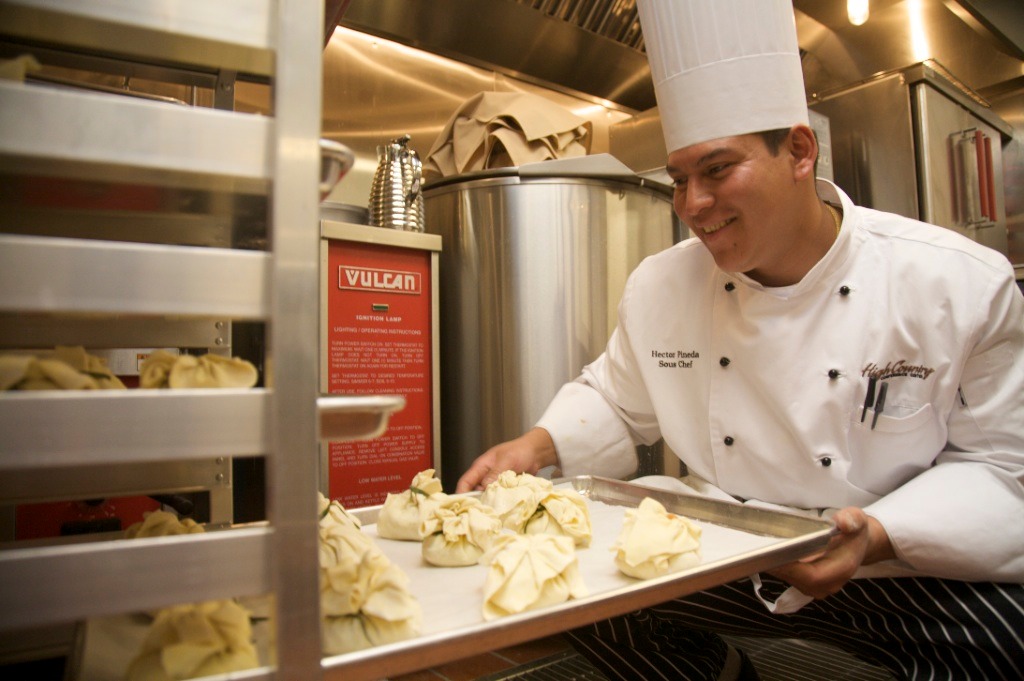
The chefs at the new High Country Conference Center can feed up to 1,200 people a meal, but it’s not the big groups of hungry conference-goers that challenge them—it’s their eagerness to serve up the “wow factor” on every plate.
“We work to make meals that are going to be remembered,” says certified executive chef John Fitzgerald. “We want today’s luncheon to be impressive so people really want to come back.”
As Fitzgerald and executive sous chef Hector Pineda prepare 75 lunches for the American Council on Education women’s leadership conference, they move in harmony among the galley’s shiny stainless steel tables and countless cooking accoutrements. The 2,200-square-foot state-of-the-art kitchen almost seems a part of “Chef Fitzy” and Pineda, nicknamed Mango, for his magnificent mango salsa.
“Before we started here, we agreed that every single item we serve will taste the best that it ever will, and that everything would be well-seasoned and attractively presented,” Fitzgerald says.
The lunch is phenomenal. It begins with a colorful plate of mixed greens topped with buffalo mozzarella and heirloom tomatoes. The main entrée follows—salmon Wellington, served with three-cheese and garlic mashed potatoes and asparagus bundled with yellow squash. Fitzgerald also creates his own desserts, pastries and muffins. For this group, dessert is a delightful tiramisu.
|
Working fast and efficiently, the chefs conjure up special requests for gluten-free, dairy-free and vegetarian lunches, but their work only appears magical. The chefs coordinate their menus weeks ahead of time to create cuisine for hundreds of people at a time.
“Timing is everything in this line of work,” Fitzgerald says. He wraps fresh dough around well-seasoned roasted peppers, tomatoes, portobello mushrooms and artichoke hearts for one of the three vegetarian Wellingtons. To hold the dough together, he deftly ties it with a twist of chives.
Fitzgerald brings 28 years of chef experience to the conference center. A graduate of the renowned Culinary Institute of America in Hyde Park, N.Y., his résumé boasts of numerous awards and chef positions at resorts and conference centers throughout the country. When asked what first sparked his interest in cooking, his warm smile lets loose. “When I was in high school, schools opened up home economic classes for boys. I ended up in one of those and loved being in the kitchen.”
Sous chef Pineda began cooking in his Guatemalan hometown when he was a teen. He spent years as a chef at Little America Hotel in Flagstaff and worked for Fitzgerald as an executive chef at the Pinewood Country Club in Munds Park, Ariz., where Fitzgerald was a general manager. “We work great together,” says Pineda, whose goal is to become a certified executive chef. “There’s no big division in the kitchen of he does this or I do that. We approach it together and put a lot of talent into every single thing we do.”
Scott Pasch, general manager of the conference center, said he designed the kitchen for a team like Fitzgerald and Pineda. “Great attention was paid to the organization and flow of the space,” he says. “We wanted a kitchen that allowed a few very skilled chefs and staff to produce exceptional cuisine in the most efficient manner, with an emphasis on food safety.”
Hundreds of chefs applied for executive chef position. Fitzgerald nailed the job after competing with two other finalists by creating a meal out of 10 surprise food items for Pasch. “His cuisine showed a maturity with a creative flair that can only come from excellent training, a natural talent and many years worth of refinement in the kitchen,” Pasch notes.
Fitzgerald continues to refine his recipe for success.
“Our first night cooking was for the Flagstaff Symphony gala, and that got us off on the right start,” Fitzgerald says. “Everything went well, right from the beginning. The food was great. Service was great. We heard it was one of the best events ever in Flagstaff. That’s what it is all about.”



